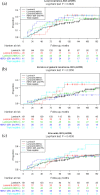Molecular subtypes in ductal carcinoma in situ of the breast and their relation to prognosis: a population-based cohort study
- PMID: 24171825
- PMCID: PMC4228470
- DOI: 10.1186/1471-2407-13-512
Molecular subtypes in ductal carcinoma in situ of the breast and their relation to prognosis: a population-based cohort study
Abstract
Background: Different molecular subtypes of breast cancer have been identified based on gene expression profiling. Treatment suggestions based on an approximation of these subtypes by immunohistochemical criteria have been published by the St Gallen international expert consensus panel. Ductal carcinoma in situ (DCIS) can be classified into the same molecular subtypes. Our aim was to study the relation between these newly defined subtypes and prognosis in DCIS.
Methods: TMA including 458 women from a population-based cohort with DCIS diagnosed 1986-2004 was used. Stainings for ER, PR, HER2 and Ki67 were used to classify the surrogate molecular subtypes according to the St Gallen criteria from 2011. The associations with prognosis were examined using Kaplan-Meier analyses and Cox proportional hazards regression models.
Results: Surrogate molecular subtyping could be done in 381 cases. Mean follow up was 164 months. Of the classified DCIS 186 were Luminal A (48.8%), 33 Luminal B/HER2- (8.7%), 74 Luminal B/HER2+ (17.4%), 61 HER2+/ER- (16.0%) and 27 Triple Negative (7.1%). One hundred and two women had a local recurrence of which 58 were invasive. Twenty-two women had generalised disease, 8 without a prior local recurrence. We could not find a prognostic significance of the molecular subtypes other than a higher risk of developing breast cancer after more than 10 years of follow-up among women with a Triple Negative DCIS (OR 3.2; 95% CI 1.1-9.8).
Conclusions: The results from this large population-based cohort, with long-term follow up failed to demonstrate a prognostic value for the surrogate molecular subtyping of DCIS using the St Gallen criteria up to ten years after diagnosis. More than ten years after diagnosis Triple Negative DCIS had an elevated risk of recurrence.
Figures


References
-
- Goldhirsch A, Wood WC, Coates AS, Gelber RD, Thürlimann B, Senn HJ. Panel members. Strategies for subtypes–dealing with the diversity of breast cancer: highlights of the St. Gallen International Expert Consensus on the Primary Therapy of Early Breast Cancer 2011. Ann Oncol. 2011;22(8):1736–47. doi: 10.1093/annonc/mdr304. - DOI - PMC - PubMed
-
- Sorlie T, Perou CM, Tibshirani R, Aas T, Geisler S, Johnsen H, Hastie T, Eisen MB, van de Rijn M, Jeffrey SS. et al.Gene expression patterns of breast carcinomas distinguish tumour subclasses with clinical implications. Proceedings of the National Academy of Sciences of the United States of America. 2001;98(19):10869–10874. doi: 10.1073/pnas.191367098. - DOI - PMC - PubMed
-
- Goldhirsch A, Winer EP, Coates AS, Gelber RD, Piccart-Gebhart M, Thürlimann B, Senn HJ. Panel members. Personalizing the treatment of women with early breast cancer: highlights of the St Gallen International Expert Consensus on the Primary Therapy of Early Breast Cancer 2013. Ann Oncol. 2013;24(9):2206–23. doi: 10.1093/annonc/mdt303. - DOI - PMC - PubMed
Publication types
MeSH terms
Substances
LinkOut - more resources
Full Text Sources
Other Literature Sources
Medical
Research Materials
Miscellaneous

